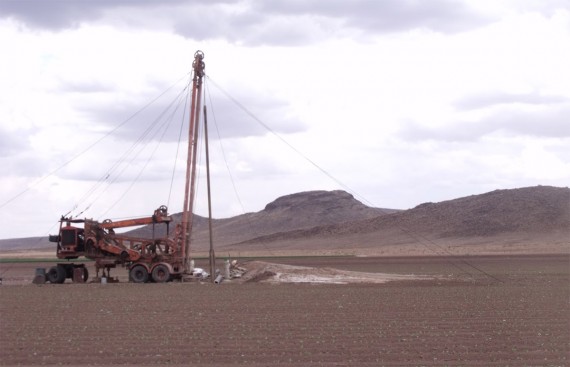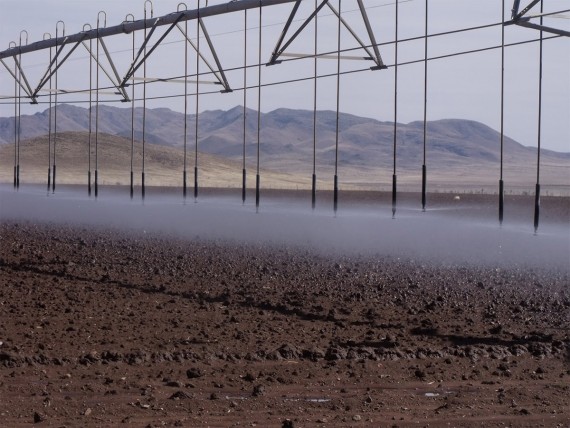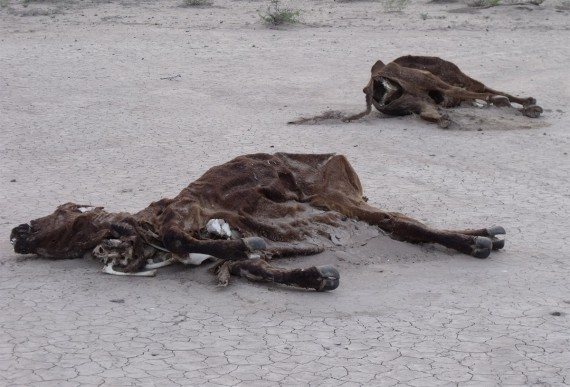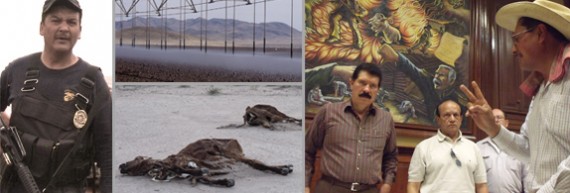Page 2
While government institutions like Conagua (National Water Commission) are primarily responsible for the proliferation of unsustainable well-drilling and irrigated agriculture, “the main beneficiaries have been the Mennonite farmers who have the money to bribe and pay for illegal permits,” he said.
“We are now cultivating 200,000 more hectares (494,210 acres) than the subsurface water basins can sustain,” Solís said, “This has mostly happened in the past five years, principally by Mennonite producers, 95% by our calculations, as cattle ranches are converted to agribusiness operations without anyone really knowing how much water is available.”
The new year has brought little improvement in the water crisis across the border and no diminishment of the tensions. In an attempt to assuage rising tensions with the Mennonites and to allay the rising fears that climate change and the continuing drought will destabilize the society and economy of northern Mexico, President Peña Nieto did what Mexican governments always do.
On Jan. 13, Mexico’s new president announced the creation of a new bureaucratic initiative, called the Programa Nacional Contra La Sequía—basically a crop and cattle insurance program to compensate select farmers and ranchers from losses suffered from the continuing sequía (drought).

“But ye are a chosen generation, a royal priesthood, a holy nation, a peculiar people.” --Peter 2:9, King James Bible
Mexican Mennonite insularity is largely self-imposed and self-defined.
Like the Mormons who established their first colonies in Chihuahua in 1885, the Mennonites regard themselves as special, chosen and undeviatingly righteous. The Mexican Mennonites, who emigrated from Canada to Chihuahua in the 1920s, believe that they are literally God’s people, the true tribes of Israel.
Mennonites are followers of Menno Simons (1496-1561), an Anabaptist leader who was a contemporary of the Protestant Reformers in the first half of the 16th century. Search for land to establish their self-reliant communities led the Mennonites across Europe and eventually into Russia. Their Biblical fundamentalism mandated that these chosen people continually flee the new Babylons: “Come out of her, my people that ye be not partakers of her sins, and that ye receive not of her plagues” (Revelation 18:4).
In 1870 the ancestors of today’s Mexican Mennonites emigrated from Russia to Canada, bringing with them a religious determination to transform frontier territories into productive farming districts. But the insistence by the Canadian provincial governments that the Mennonite children attend public schools spurred yet another emigration—this time to the sparsely inhabited valleys, basins and intermontane plains of Mexico’s largest and least populated state, Chihuahua, in the 1920s.
The roughly 80,000 Mennonites—known commonly by other Mexicans as menonitas or menones—who currently live in Chihuahua are Mexican citizens—as Mexican as the next Mexican. Their pickups have Mexican plates, they hold Mexican birth certificates, and they vote (usually as a bloc) in local and national elections.
But unlike other Mexicans they benefit from a Privilegium—an agreement between Mennonite colonizers and national governments that bestows special status and privileges.
In Mexico in 1921, President Alvaro Obregón granted the archly conservative Altkolonier Mennonites from Canada the right to establish agricultural enclaves in Mexico—with sparsely occupied Chihuahua being the principal destination.
The Privilegium, modeled after similar agreements around the world, specified that the Mexican government would allow the emigrating Mennonites to satisfy their “desire to establish yourselves as agricultural settlers in our country.” And the government agreed that the Mennonites would not be obligated to serve in the military, swear oaths or attend public schools.
What is more, the revolutionary-era Mexican president agreed to allow that “you may administer your properties in any way or manner you think just” and “may establish among yourselves economic regulations.”
More than nine decades later, it seems—at least at first glance—that little has changed. The Mennonite women continue to bundle their long hair in black, blue or green headscarves. Straw hats still remain common headgear for Mennonite men and boys, although increasingly they sport baseball caps (always cap forward, though).
Most of the men speak functional and sometimes fluent Spanish, but the girls and women are still largely monolingual. That keeps them eerily restricted to their enclaves, where men set all the rules—religious, social, cultural and economic—outside the kitchen.
Mennonites still live in self-contained colonias (divided into numerous campos) in remote areas, virtually hidden from the mexicanos—the common term Mennonites use to identify non-Mennonite Mexicans. The government continues to honor the original Privilegium, and the Mennonites have prospered and multiplied under its provisions.

“The wilderness and the dry land shall be glad for them; and the desert shall rejoice, and blossom as the rose.”—Isaiah 35:1, King James Bible
Over the past two decades, the Mexican Mennonites have left behind their wooden plows and horse-drawn buggies and threshers. Except for the rare Mennonite colonia, like Sabinal, the modern Mexican Mennonites largely left behind their history (and ethic) of non-mechanized agriculture. Mennonite farmers now enthusiastically embrace the high-tech, capital-intensive, chemically saturated, and bioengineered habits of US and Canadian agribusiness.
With endless work, religious fervor and no worldly distractions, the Mennonites have transformed the Chihuahuan Desert and grasslands into an agribusiness apex: no desert, no mesquite, no birds, no natural flora, no fauna, nothing but laser-defined rows of crops, rotary irrigation systems spraying a bounty of water onto cash crops.
In sharp contrast to the Mexican towns, there is absolutely no street life and no bright colors. But an exaggerated sense of order prevails over these antiseptic communities of gray homes, gray warehouses, and gray schools and community centers.
The community patriarchs govern the settlements, but the lords and idols of the society and economy are the ubiquitous agricultural implements and machinery. The Mennonite men and women live to work, yet the lifeblood of these agricultural realms comes from the machines, the electricity grids, the omnipresent wells and pumps, all working day and night to make the desert bloom.
You might, if you are a nonbeliever, think you have stumbled upon an agribusiness Babylon—where man, machines and chemicals have turned the desert an unnatural green.
The new agribusiness boom is not dependent on annual rainfall or snow melt but on a proliferation of new wells that plumb groundwater that has accumulated over the millennia in closed basins under the desert landscape.
Private ranches and especially the government-granted ejidos have been devastatingly overgrazed, and the ongoing drought has made continued cattle ranching all but impossible. There’s nothing left to forage—precipitating a massive sell-off of ranch lands to Mennonites and agribusinesses that tap groundwater to irrigate the arid landscapes.





Responses to “The Coming Water Wars in Mexico”